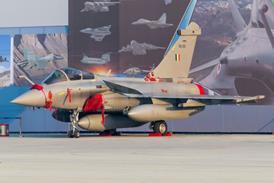At the beginning of 2018, it would have been hard to pick out Boeing Defense, Space & Security as poised for a comeback. At that time, the ailing division was struggling to shake off a narrative of decline, and also received no help from US Air Force Secretary Heather Wilson, who in March publicly lamented the company's always late and never quite functional KC-46A tanker.
But over the course of about 30 days across August and September, Boeing's defence unit rewrote its story with an impressive streak of contract wins.

Boeing
On 31 August, the US Navy awarded the company an $805 million contract to develop and produce four MQ-25A Stingray carrier-based unmanned refuelling aircraft. A few weeks later, on 24 September, the firm was granted the first portion of a $2.38 billion firm, fixed-price contract to replace the USAF's Bell UH-1N utility helicopter fleet with the MH-139; developed with Leonardo Helicopters from the commercial AW139. Then, three days later, the air force selected it for its $9.2 billion T-X requirement, covering the production of 351 jet trainers, plus 46 simulators and associated ground equipment.
Previously, Boeing's defence revenues had fallen by more than one-third over the space of a decade: from $32.1 billion in 2007 to $21.1 billion in 2017. But the rapid-fire succession of recent contracts, combined with orders announced earlier this year for dozens of legacy aircraft, has reversed the division's fortunes.
So, what has been the company's turnaround strategy?
"Be aggressive on price and leverage other people's design work," says Richard Aboulafia, vice-president of analysis at the Teal Group.
As a case in point, the firm's $9.2 billion T-X bid came in far below the USAF's initial estimate of $16.3 billion, and in part relied on aft fuselage design work performed by its partner, Saab. Boeing plans to run final assembly of the T-X trainer in St Louis, Missouri, and anticipates Saab moving aft fuselage production to an as-yet-unannounced location in the USA. The USAF plans for the Northrop T-38 replacement to achieve initial operational capability by 2024, with full operational capability to follow by 2034.
Other programmes have the same hallmarks. Boeing jointly bid with Leonardo Helicopters on the military-variant MH-139 to win the USAF's UH-1N fleet replacement contract – a bid Wilson says was successful "at a significantly lower price point" than expected for the planned 84-aircraft deal.

Boeing
And while Boeing's winning MQ-25 bid was a clean-sheet design, the company also hedged its bets in the carrier-based tanker competition, by making a separate, joint bid with General Atomics Aeronautical Systems.
PRICE FLEXIBILITY
Boeing can afford to aggressively cut prices on these programmes, presumably delaying profits, because the commercial airliner side of its business generates so much cash, says Aboulafia. Revenue from Boeing Commercial Airplanes rose by 153% between 2003 and 2017, to reach $56.7 billion, according to financial filings. The company earned $5.4 billion from the division last year.
"That gives them a lot of flexibility in terms of price," Aboulafia says. "They also have a lot more leverage in negotiation with suppliers for products."
For its part, Boeing declines to discuss its strategy, until the protest periods are complete following the trio of recent selections.

Boeing
Nonetheless, many analysts believe it aims to make profits later on, via selling maintenance, repair and overhaul agreements. The firm may also sell data services, such as analysis of fleet performance and reliability, and supply-chain and inventory optimisation. Both business lines are part of an ambitious effort by the company to grow its Global Services division to $50 billion by 2025.
The company could also be banking on the international sales potential of its new portfolio of military aircraft, particularly with its single-engined T-X. "If the air force is behind this aircraft as their trainer, that should lead to additional international sales as well," says Sam Pearlstein, a stock analyst with Wells Fargo.
But the T-X's international potential may be limited, Aboulafia believes. "The problem is the export market for this type of aircraft isn't fantastic," he says. "Maybe they think they could grow this market."
HARD SELL
Boeing has tried this international sales strategy before, aiming to sell the 767-based KC-46A to foreign militaries – an approach that has so far only yielded one sale, to the Japan Air Self-Defence Force.
The dearth of international sales, combined with $3.4 billion in pre-tax charges the KC-46A programme has taken over its history, makes the prospect of profits on the aircraft line dubious, says Pearlstein. The tanker has been plagued with production difficulties, such as sunlight glare problems with its refuelling boom camera, which have increased costs and delayed delivery until a revised schedule of later this month.

Boeing
"Fixed-price contracts invariably add risks if you get delayed or your costs go up, as we've seen with the tanker," Pearlstein says. Notably, all three of Boeing's recent wins include varying types of fixed-price provisions.
Boeing’s ability to transform its cut-rate contract awards into profitable businesses may be uncertain, but turning around declining revenue and reinvigorating the company's engineering know-how via the clean-sheet designs of the MQ-25A and T-X trainer also have value in themselves.
"Obviously, it keeps the defence unit strong to prepare for the next round of competitions, which is coming onto the horizon for the next generation of fighter aircraft in particular," says Aboulafia. "It’s been well over 40 years since they've designed and built their own combat aircraft. If they are wise, they will use these for the next round of competitions."
Source: FlightGlobal.com















































